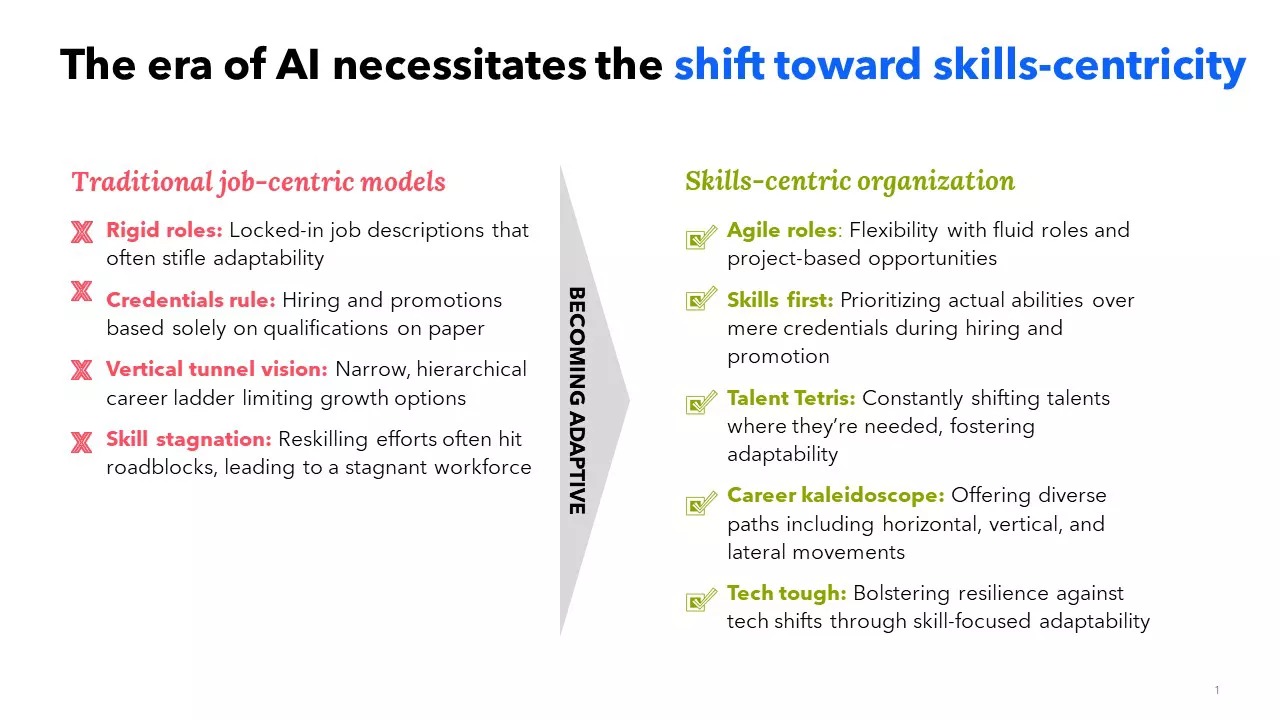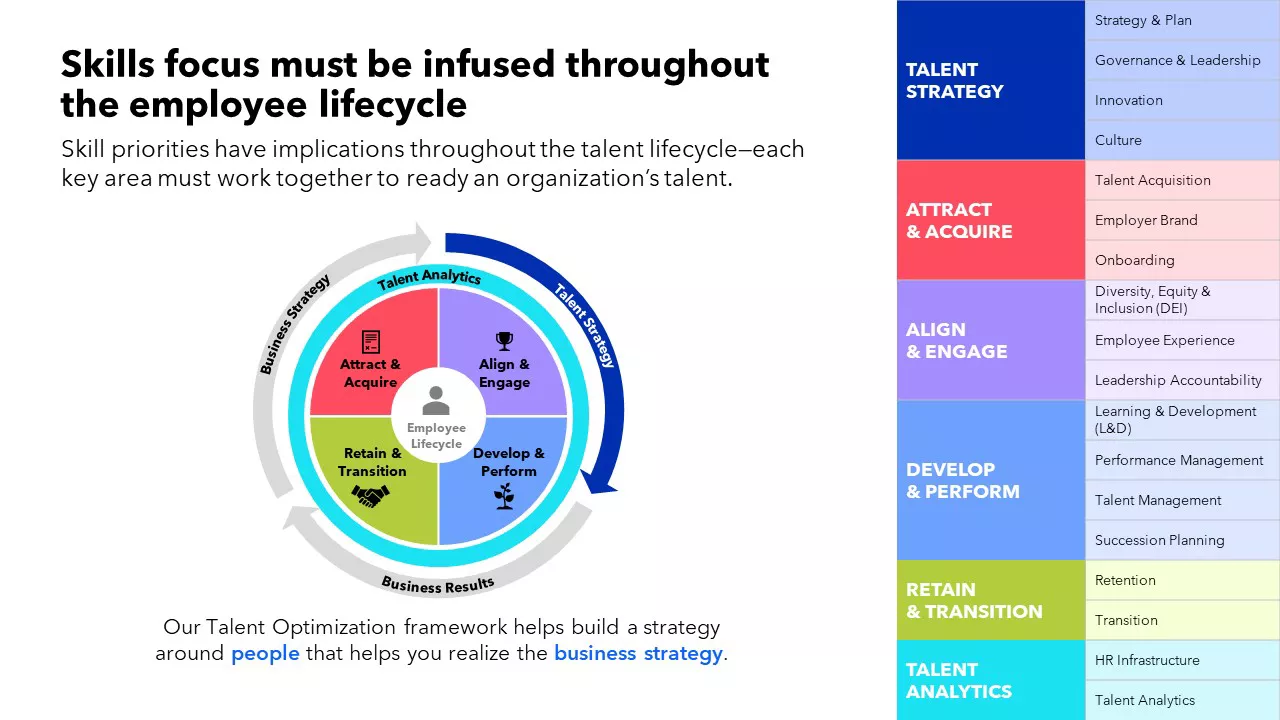Embracing a skills-centric workforce in the AI era

Picture the typical office of yesteryear: employees confined to strict roles, hiring decisions based on résumés filled with credentials, and career ladders that only go up or down.
This approach stifles creativity, limits adaptability, and leaves organizations ill-prepared for rapid technological changes.
Now imagine a bustling workplace where roles are as fluid as the conversations. A software engineer might take on a project management role one week while a marketing specialist contributes to product development the next. This is the reality of a skills-centric organization.
As we navigate an era increasingly dominated by AI, traditional job-centric models with rigid role definitions and ladder-like career progressions are becoming relics of the past. According to our 2024 AI research report, 57% of leaders are redesigning roles to free employees of repetitive tasks through automation, allowing them to focus on higher-value work. It's vital for today's organizations to become adaptive by cultivating a future-ready talent network that prioritizes skills.
The shift from job-centric to skills-centric
In the traditional job-centric model—where roles are strictly defined, job descriptions rarely change, and employees are hired and promoted based on prior experience rather than their skills (or potential to learn new ones)—organizations risk suppressing innovation, hindering flexibility, and creating inefficiencies as roles fail to evolve with the pace of technological change. Organizations that haven’t yet adapted will find themselves in a never-ending state of talent flushing: removing talent to meet budgetary requirements and then hiring new talent with the skills needed to keep up with the competition. Not only is this an incredibly expensive way to manage talent, but it can also negatively impact team cohesion, team productivity, and organizational culture.

In contrast, a skills-centric model emphasizes employees’ skills and capabilities over specific job titles or past experiences, allowing for greater flexibility and fluid movement across projects based on both skills and the evolving needs of the organization. This approach fosters continuous learning and adaptability, ensuring that the workforce can quickly respond to emerging challenges and opportunities.
As capability leaders within a large CPG organization recently noted, “Our move to a skills-based organization is driven by our desire to offer more growth opportunities for our employees that extend well beyond their existing team, department, or organization.” They view this shift as essential to creating a global talent marketplace enabling greater flexibility and adaptability in the face of accelerating technological change.
Adaptive organizations thrive by continuously evolving their workforce and leveraging AI to drive efficiency and innovation. These organizations optimize human capabilities, streamline workflows, and build a resilient, innovative workforce. Transitioning to an adaptive model requires aligning the organization’s strategy with a comprehensive approach to skill development, job redesign, and leveraging automation.
Why adaptation is vital
Think back to the last time you upgraded your smartphone. Remember the excitement of exploring new features and capabilities? Now, imagine if you had refused to upgrade and stuck with your old device. You’d quickly fall behind, missing out on advancements and opportunities.
The same principle applies to organizations: clinging to old methods is a surefire way to become obsolete. Embracing a skills-centric model is like upgrading to the latest technology—it’s about unleashing hidden talents and creating new pathways for growth and success.
The modern business environment demands flexibility, rapid learning capabilities, and a workforce that can adeptly navigate changing technological landscapes. Organizations that continue to cling to outdated structures risk significant disadvantages in innovation, responsiveness, and market position. The future belongs to those who can adapt and reinvent themselves continuously. It’s time to break free from the confines of job boxes and unleash the full potential of your talent.
Creating a modern workforce
While we can’t predict the future with certainty, we can make informed predictions based on labor market and workforce trends as well as our observations of the companies and organizations we engage with regularly.
Future-stable skills: The future workforce is set to undergo significant transformations driven by technological advancements, requiring a blend of digital literacy, social creativity, emotional intelligence, and an increasing importance of soft skills. As automation and AI become more prevalent, critical thinking and problem-solving will be vital, alongside a commitment to continuous learning and professional development.
Culture of continuous learning: Building a modern workforce requires not only hiring new talent but also investing in existing talent to develop the skills needed for tomorrow. Organizations must implement strategic workforce planning that emphasizes skill development, broad exposure to emerging technologies, a culture of innovation, and creative employee growth strategies. These measures will ensure that the workforce remains engaged as well as competitive and prepared for the challenges of the future job market.
Workforce resiliency: To build business resiliency, companies must cultivate a diverse workforce capable of quickly adapting to and overcoming challenges, setbacks, and obstacles. A highly resilient workforce leads to greater employee engagement and retention, stabilizing expertise and reducing turnover costs. Ultimately, investing in workforce resilience enables a company to thrive in both the present and the future, maintaining relevance and competitiveness.
Job evolution: We’re seeing the deployment of AI tools replace or erode many jobs, especially entry-level and manual-routine roles. While job obsolescence may be an ongoing pattern, AI will necessitate the creation of new roles across data science, data product management, AI governance, and beyond. Continuous skilling, paired with intelligent human-AI collaboration, will be essential for building a future-ready talent network that enhances efficiency without resorting to downsizing. Maintaining a focus on emerging skills will be crucial for optimizing efficiency and utilization as AI reshapes jobs.
Modernized HR tech stack: The HR technology landscape is also rapidly changing as AI is integrated into existing systems and new software emerges with AI as its backbone. Leaders should be considering where skills are housed, how they’re maintained, and how their organization can evolve into a highly dynamic and interactive talent marketplace. Reevaluating your existing technology landscape and making the strategic investments that align to your modern workforce strategy are key to building a foundation that can evolve with your organization.
Bringing the vision to life
Embracing a skills-centric workforce may seem daunting, but it offers an exciting opportunity for growth and innovation. We suggest starting by examining your talent lifecycle to identify where and how skills can be introduced, as well as opportunities to modernize approaches and ways of working. By integrating your people strategy with business strategy, you will mobilize talent more effectively to achieve business outcomes and create a dynamic and adaptable workforce prepared for the future.
Slalom’s approach provides the roadmap and tools necessary to build a skills-centric and adaptive organization, guiding you every step of the way.

Conclusion
Organizations that adopt a skills-centric approach—prioritizing future-proof skills, skills-based hiring, dynamic talent redeployment, and fostering a culture of continuous learning—will be better equipped to navigate the complexities of the modern business environment and ensure sustained innovation and competitiveness in the years to come. Becoming an adaptive organization with a future-ready talent network isn’t just a strategy for success—it’s essential for survival in the AI era.
Just as an upgraded smartphone opens new possibilities, a skills-centric workforce unlocks the potential for a brighter, more adaptable future. Shift your focus from rigid job roles to the vast potential of your employees’ skills and unlock a future of endless possibilities.
So, ask yourself: Is my organization ready to embrace the future?



